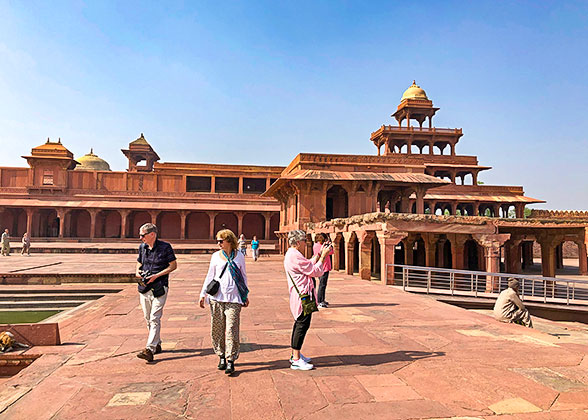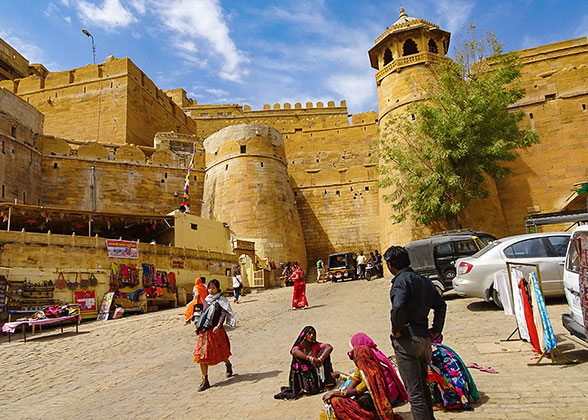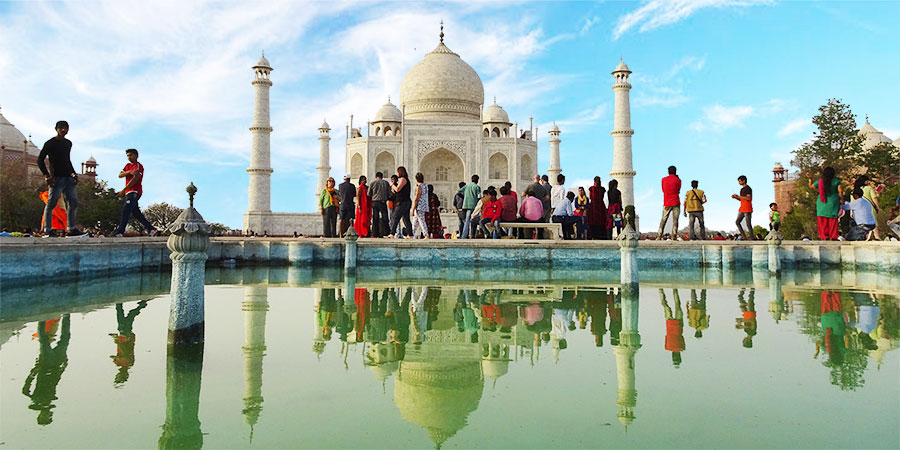Jama Masjid, Agra
The 16th and 17th centuries saw Agra in a place of prominence as the capital of India. This was also the makeover for the city when a lot of monuments, forts, palaces, and other important structures were built in the city. The glorious mosque is one of India’s largest mosques built by the Mughals. The Jama Masjid of Agra or Jami Masjid as it is nicknamed, sees thousands of devotees turning up for special Friday Namaz hence another name the ‘Friday Mosque’. The mosque was visited by the Nawabs and their queens even in later days.As one of the important landmarks of the city, the mosque is located amidst the crowded local bazaar. It stands tall on a high platform with five arched entrances providing access to the courtyard. The main entrance to the mosque is through the eastern side. The complex also houses the Panch Mahal, Jamat Khana next to the Zenana Rauza, the royal tombs of imperial women. The beautiful paintings, beautiful Chajjas, domes with inverted Kalash and Lotus motifs, slender turrets, pillared Dhallans, scrupulously carved Chattris, and cloisters with designed arches make this place so fit for royalty. The elegant Miraabs and pulpit increase the beauty of the inner walls of western sides multi-fold.

|
History of Jama Masjid
Jama Masjid was commissioned by Shah Jahan in 1648 AD in dedication to his favorite daughter Jahan Ara Begum. The mosque came to life in six years and with the contribution of over 5,000 laborers and artisans.
It was later chosen by Shah Jahan to be a sacred place for building the tomb of Sheikh Salim Chishti. As per the history, the Mughal Empire was praying for an heir to the dynasty. However, there was no luck. Shah Jahan earnestly sought blessings from Sufi Saint Sheikh Salim Chishti and was a son through his divinity. The son was named Salim after his who ruled the dynasty after the tenure of Akbar, as Emperor Jahangir. Deeply obliged, and to mark his gratitude, Emperor Akbar dedicated a mosque and a city to honor the saint. A royal tomb of the revered Sufi Saint was made in red stone after his death. Later another tomb in White marble was also erected to mark the saint.
Architecture of Jama Masjid
The mosque is made of white marble and red sandstone in a unique blend of Hindu and Muslim architecture with a hint of Iranian designs. The domes have scrupulously designed zig-zag patterns that are worth–seeing. These are made by cementing alternate bands of white marble and red sandstone in perfect harmony that too without must sophisticated machinery in those days.
The inside walls of the mosque are beautifully done in Petra Daura work and have marble inscribed in inlaid black stone with Quranic verses and praises of Shah Jahan and his daughter Jahan Ara in Persian style. The fountain at the center of the courtyard is flanked by four kiosks. The intricate designs with sandstone and marbles in many colors and the inlaid work are found in most of the monuments from the Mughal Era and were inspired by that of the Taj Mahal. The masjid is of great significance amongst the community and Indian history. The mosque is so big that it can accommodate about 25,000 people at a time.
|
|
How to Reach
The Jama Masjid is very close to the Agra Fort Railway Station which is located right in between the mosque and the Agra Fort. It is located in the heart of Fatehpur Sikri. Earlier there was a Tripolia Chowk in between the Delhi Gate of Jama Masjid and the Agra fort. This is the site that was used for building Agra Fort Railway Station. Agra is well connected with other cities and countries. You can take a taxi from the airport to reach the Masjid. Trains are yet another eco-friendly and pocket-friendly option from anywhere in India.
Most of the trains pass by the main Agra Railway Station and very few passes through the Agra Fort Railway station. However, plenty of auto-rickshaws and taxis (both pre-paid and private) commute between these two railway stations. The Jama Masjid is well connected internally too. Hence there is no dearth of taxis and cabs from any part of the city to Jama Masjid.
Time Required: 1-2 hours
Entrance Time: 7:00 AM to 12 Noon, 1.30 PM to 6.30 PM
Entrance Fee: The mosque remains closed on Fridays for non-Muslims as it is the day for special prayers. For the rest of the days, the entrance fee is:
• INR 50 for Indians
• INR 90 for SAARC/ BIMSTEC countries
• INR 610 for Foreigners.
• Cameras/phones are charged at Rs. 30 per item.
|
|
Travel Tips:
1. Shoes are to be removed before entering the mosque. The shoes can either be kept outside the mosque or carried in the backpack if you have one.
2. Be prepared as the ground is going to be mighty hot especially in summers and afternoons. Even though mats are there but they are in sparring numbers and one must get in touch with the ground.
3. The mosque is clean but the outside is not. Unpleasant smell and the sight may mar your experience. It is better to go prepared to save the experience.
4. Aligning to old patriarchal rules of the Muslim religion, women are not allowed inside the mosque.
5. Fridays are very crowded due to weekly prayers and must be avoided if travel is your sole purpose. Only Muslims are allowed during the prayers in the mosque.
6. There are a lot of Muslims staying there. It is a good place to observe a typical day in their life. One can find them engaged in their daily chores like reading the Quran etc. All this must be done of-course without disturbing them.
7. The dictum requires you to dress modestly with knees and arms completely covered.
Read more: The Tomb of Salim Chisti – A Magnificent Marble Structure





